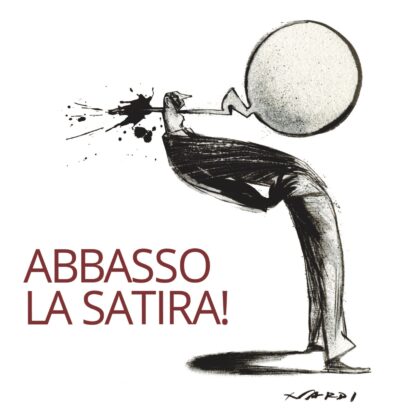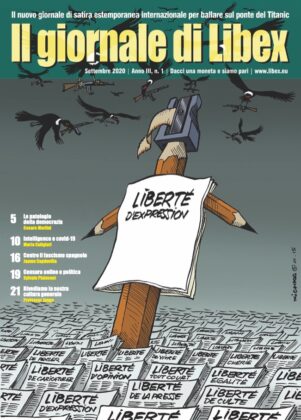Cartoon by Marilena Nardi
As part of the Lector in Fabula 2017 festival on the theme “It’s easy to say Revolution”, the center LIBREXPRESSION presents, in the beautiful cloister of the Monastero San Benedetto in Conversano, an illustrative exhibition of the theme. The exhibition will be open from 14 to 25 September 2017. There are 57 illustrations and cartoons, since 1989 to the revolutions of the Arab spring, with cartoonists from many European countries, from the Maghreb, USA, Argentina and Burkina Faso.
Revolution, Révolution, Revolución, Επανάσταση, Революция! Rivoluzione
[rev-uh-loo-shuh n] noun (1) celest movement, sinonym of period, return to the starting point; (2) whatever lasting storical process or movement, even non violent, through which is achieved a radical change in the socio-economic and political structures, or in specific activities sectors (3) radical mutation, transformation or innovation (4) fig. overthrow of manners and customs (sexual revolution), habits or physiological functions (5) moral: senses revolution against reason.
These are some of the definitions of this polysemic word. Whatever is the historical period or the language, it seems that there is – at least since the 18° century – a common understanding of this noun. Nevertheless, “It is easy to say revolution” as proclaims the title of the festival Lector in Fabula’s thirtieth edition during which this exhibition is organized. Certainly, it is easy to wrongly qualify some changes or revolts as “revolution”, if the core meaning of this world is to be understood as a radical change in the economical-social-political structures or in the manners and customs, that is to say as a radical transformation of the society. It is for this very reason that the Center LIBREXPRESSION decided to enquire on the meaning of this concept both through selected historical graphic representations and by asking to well-known artists and cartoonists from many countries (Italy, France, Denmark, Netherlands, Turkey, Ukraine, Cuba, Argentina, Tunisia, Morocco, Burkina-Faso, Iran) to represent their own concept and interpretation of “revolution” (being past, present or future ones).
This exhibition “From revolution to post-revolution” is presented in the Monastery San Benedetto’s cloister of the wonderful historic city of Conversano (Italy), from the 14th to the 24th of September 2017. It proposes a thematic and historical tour on “revolutions” that produced radical transformations of our societies, starting from the “mother” of all revolutions, the French revolution of 1789-1794, up to the Arab revolutions of these last years, with an obvious special attention to the 1917’s Russian revolution. From the Johannes Gutenberg technological revolution, with the invention, circa 1449, of the mechanical movanle type printing, permitting also the reproduction of engravings, publication of political (and religious) satire engravings developped all over Europe thanks to famous painters like Luca Cranach, Albrecht Dürer, Pieter Brueghel, Hans Holbein, Jacques Callot, Annibale Carraci, etc. From then onwards, grahic political satire will become a powerful tool for revolutionnaries and for their adversaries, and will be increasedly used thanks to the invention of lythography by the German Aloys Senefelder in 1796. Lythography will facilitate large scale reproduction of images specifically in the paper press and the creations of illustrated satirical magazines. From the beginning, graphic satire has been (and still is) considered by the political or religious powers as a mortal danger so as to unchain censorship, penalties, persecutions, imprisonment and murder of these democracy’s soldiers that are the satirical cartoonists.
Often, political revolutions, like astronomical revolutions, bring back to the starting point. The search for democracy, equality, basis of most of the revolutions since 1789, was not always successful to achieve these objectives, even if they provoked changes and hopes for a better future. As the cartoonists of this exhibitions show, these hopes for a better human future could disappear with the global domination of the information technologies revolution. This later could potentially anaesthetizes any revolution tendency, containing the germs of a radical change not any more of the society, but of the human being into a puppet, what could be defined as a post-revolution.





